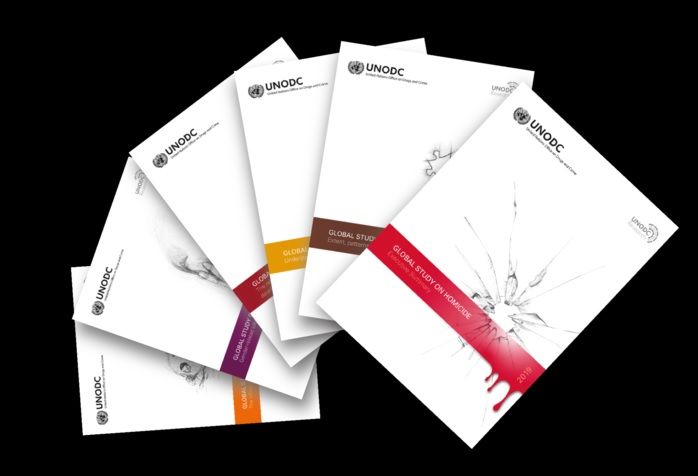Latin America with the highest number of homicides in the world due to inequality and organized crime
It has only 13% of the world's population but accounts for 42% of all violent deaths. El Salvador, Venezuela, Brazil, and Mexico lead the way.

Latin America has only 13% of the world's population but accounts for 42% of all violent deaths. El Salvador, Venezuela, Brazil, and Mexico lead the way.

Although the American continent is home to only 13% of the world's population, 42% of all homicide victims are registered here, a situation that is especially serious in Latin America and in which problems of inequality, weakness of the judicial system, and the strength of organized crime converge.
The 2019 World Homicide Study published this Monday in Vienna by the United Nations Office on Drugs and Crime (UNODC) indicates this.
The average annual homicide rate in the continent is 17.2 per 100,000 inhabitants, almost three times the world average and almost six times more than Europe.
Central America, with 25.9; South America, with 24.2; and the Caribbean, with 15.1, are the subregions with the highest homicide rates on the planet.
The Americas is the only region where this rate has grown since 1990.
The only four countries in the world with homicide rates of more than 40 people per 100,000 inhabitants are in Latin America: El Salvador (62.1), Venezuela (57), Jamaica (57), and Honduras (41.7).
UNODC particularly highlights the case of Venezuela, where there has been "the most dramatic increase" in the homicide rate, from 13 to 57 per 100,000 inhabitants between 2012 and 2017.
In Brazil, the homicide rate rose to 30 in 2017 and it is estimated that 1.2 million people have been victims of intentional homicides between 1991 and 2017.
The rise in deaths in this country and Mexico, both heavily populated, explain much of the global rise in homicide rates in the past two years, after decades of decline.
By contrast, the UNODC highlights the reduction in the number of homicides experienced by Colombia in that period, from 80 to 25 per 100,000 inhabitants, something that the UNODC attributes in part to the "intensification of state action against drug trafficking.
At the bottom of the table, but still above the world average of 6.1 homicides per 100,000 people, are countries such as Argentina, Peru, Uruguay, and Nicaragua. This number arises from an average of the UN rates for the years 2012 to 2016. In the case of Argentina, in 2017 the number is 5.1.
Only Chile, with 3.1, would be below that average.
Referring to the causes of the high number of homicides in Latin America, the UNODC report points out that organized crime, especially related to drug trafficking, is behind a good part of those deaths.
"There are other types of homicides, such as violence in the couple or in the family. But the element of organized crime is much higher than in any other region of the world," explains Efe Angela Me, head of UNODC's investigation department and one of the report's coordinators.
She explains that one of the conclusions of the report is that in the case of Latin America, the idea that socio-economic development is accompanied by a reduction in violence, as is the case in Europe or Asia, is not necessarily fulfilled.
"In the world, in general, differences in homicide rates between countries can be explained mainly by socioeconomic development. Not in Latin America. The interpretation is that there is a component that other regions do not have, which is organized crime and gangs," the Italian expert analyzes.
She identifies three major causes for the grave situation in the region: inequality, impunity, and access to firearms, responsible for more homicides in Latin America than anywhere else in the world.
In the report, UNODC warns that "weak justice leads to impunity and creates an environment in which criminals can operate more easily.
In 2016, only 43% of all homicides committed in the Americas were solved by the police, the lowest rate in the world and almost half in Europe.
For this reason, the solutions go through a combination of measures: improving police work, bringing it closer to the community, investing in education, and strengthening the judicial system.
Venezuela, South America's highest homicide rate
Throughout the Americas, only El Salvador has a higher homicide rate of 62.1.
According to the study, Venezuela experienced between 1991 and 2017 "the most dramatic increase" in violent deaths in the Americas, from 13 to 56.8 homicides per 100,000 inhabitants.
Caracas, the country's capital that has been plunged into a deep political, economic and institutional crisis for years, registered 122 deaths per 100,000 inhabitants in 2017, more than doubling the national homicide rate.
The risk of being killed in the oil nation is exceptionally high for men between the ages of 15 and 29. The homicide rate for this segment of the population was 200 per 100,000 inhabitants.
The situation in Venezuela in terms of violent deaths is similar to that of other Latin American countries such as Brazil and Mexico. "They have one of the highest homicide rates in the world, and all have been affected by social and economic instability in recent decades," the report reads.
Mexico, with a record number of homicides
Mexico recorded a record number of violent deaths in 2017, with more than 30,000 homicides, according to the United Nations Office on Drugs and Crime.
The report attributes this phenomenon to "the growing disorganization of crime" in the country, and recalls that "the dominant cartels of five years ago have fragmented and diversified.
This would explain why the number of murders has increased in Mexico between 2014 and 2017 after a period of decline.
"A succession of high-level arrests unleashed conflict and fragmentation within some of the main cartels," says the document, which places 2007 as the beginning of the state's operations against the most important drug lords.
"The leader of the Sinaloa Federation, who dominated numerous drug markets for years, was extradited to the United States in 2017," recalls the report about Joaquín "El Chapo" Guzmán, whose detention by Mexican forces is considered one of the triggers of this situation. The other factor cited is the arrest or violent death of numerous leaders of the Zetas cartel between 2012 and 2018, says the report on another major drug trafficking group.
Asia, where fewer homicides are committed
Asia has the lowest homicide rates in the world, at just 2.3 homicides per 100,000 people per year, a figure that, compared to rates of 25 in Latin America, makes this continent a haven of peace.
However, the figures are not so low throughout the continent. There are huge differences in Southeast Asia. The rate in the Philippines (8.4), for example, is 42 times higher than that in Singapore (0.2).
The report notes that the Philippines has experienced a sharp increase, a reversal of a trend believed to be linked to an increase in organized crime, violence by clandestine groups taking matters into their own hands, and an increase in Islamist terrorism.
Asia's low rates are explained by highly populated countries, such as China, Japan, and Korea, having rates below one death per 100,000 people per year.
The secret? A modernization policy with an emphasis on educational attainment and a culture that rewards long-term planning, according to UNODC.
The report cites Singapore as an example of success in the fight against homicidal violence, compared to Jamaica.
After independence from the British Empire in the early 1960s, the two countries had similar socio-economic indices, political systems, and crime rates.
In 2017, Singapore had a homicide rate of 0.2 and Jamaica had a homicide rate of 57.
What has happened in those 60 years? In the Asian country, a model of corruption control, investment in health, education, and public housing was created, while in Jamaica a client system was established, with political violence and the presence of "godfathers", from which drug trafficking groups later emerged.
Homicides in the world, in figures
1. More deaths
A total of 464,000 people were victims of intentional homicides in 2017 worldwide, up from 362,000 in 1990.
2. Lower homicide rate
Although the number of homicides has increased, the increase in the population means that the rate, the number of deaths per 100,000 inhabitants, has fallen from 7.4 in 1993 to 6.1 in 2017.
3. Unequal distribution
By continent, the highest rate is recorded in America, 17.2. It is followed by Africa (13), Europe (3), Oceania (2.8), and Asia (2.3). Rates fluctuate widely internally between regions, for example between 62.1 homicides per 100,000 inhabitants per year in El Salvador and 3.1 homicides per 100,000 inhabitants per year in Chile. At the other extreme, Singapore has a homicide rate of 0.2.
4. Organized crime
Nineteen percent of all homicides in 2017 were related to organized crime. Since 2000, organized crime has killed as many people as any armed conflict in the world.
5. Man and woman
Nearly 81 percent of the homicide victims recorded in 2017 were men, as well as more than 90 percent of suspects. The imbalance is especially marked in Latin America and increases with age.
6. Sexist murders
Although women are victims in only 20% of all murders, that figure rises to 82 when it comes to homicides committed within the couple. Nearly 60 percent of the 87,000 women murdered in 2017 worldwide were victims of a male chauvinist crime committed by their partners, ex-partners, or male relatives, making the home "the most dangerous place" for them.
7. Firearms
The ease of access to firearms and homicide rates are related. In 2017, just over half of all intentional homicides were committed with firearms. In the Americas, this proportion rises to 75 percent.
8. Alcohol and drugs
Thirty-seven percent of homicides committed in 2017 took place under the influence of psychoactive substances. Ninety percent of the cases involved alcohol.
9. Impunity
In the world, 63% of the homicides committed are solved by the Police. This percentage drops to 43% in America, a continent where impunity, caused by a weak judicial system, creates an environment in which criminals operate more easily.
10. Climate crisis
The report warns that the climate crisis and the growing lack of resources, such as water, generate conflict. The UNODC refers to a 2015 report that points out that for every degree Celsius that the temperature rises, interpersonal conflicts can rise by 2.4%, and clashes between groups by more than 11%.
Sources: Europa Press, EFE, Clarin, Unodc.org




